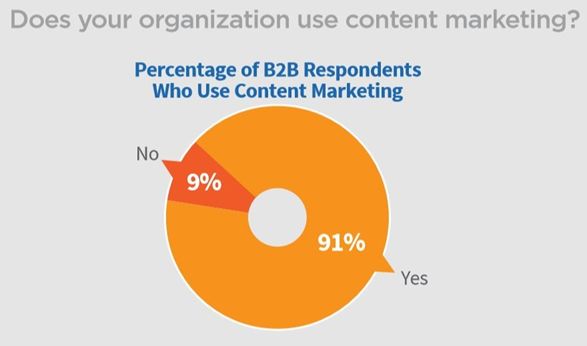Content remains the holy grail for marketers and a key component for search engine ranking. The stats do not lie.
According to Content Marketing Institute, more than 90 percent of B2B (Business to Business) marketers use content marketing, and it remains a key strategy for over 85 percent of B2C (Business to Consumers)
Despite the encouraging numbers, the top rank and massive traffic mean nothing if it does not convert.
Marketers need to focus on creating results-focused content instead of churning out company-centered messaging.
It will not happen by merely changing a few words in your existing content. Instead, you will need a content strategy that weighs heavily on buyers’ personas of the target market and cater fully to their needs.
The right strategy with proper execution can do wonders for marketers in terms of connecting with consumers and ultimately converting them. After all, connections with conversions can be meaningless for most companies.
Conversion is the ground truth for business success, but what does it really mean?
For many, it can be:
- A purchase
- A new subscriber
- A download (an app, software, or any other asset)
- Any other goal determined by your business model
All this can be made possible by rethinking your content strategy and following a plan that zeroes in on results-focused content creation. This seems obvious, but in today’s competitive environment, many marketers just craft content without considering its value proposition for the brand and the customers.
There are many ways to create engaging content, but to effectively monetize the content and convert the audience into buyers, you will need a clear content framework. Begin with market research to get things started.
Identify your audience:
If you want every piece of your content to produce results, you must understand your audience. Customer-awareness is an indispensable part of a successful marketing strategy because it enables you to predict their ‘buyer’s journey’ and tailor your content to inspire their final decision.
Customer-awareness begins with understanding their interests, likes, dislikes, beliefs, and other characteristics. Once you uncover a potential customer’s inclinations, you can then create content based on your findings. To understand your customer, consider the following information:
- Age and Gender: How old are they, and which gender do they identify with?
- Goals: What is it that the customer wants to achieve with your product or service?
- Needs: What do they expect from your product or service?
- Personality traits: What defines their behavior?
- Pain points: What might be stopping them from making a purchase?
Collecting this information can be challenging, but social media can be a helpful tool to observe your customers. Read their social media profiles and see how they react to your products. Learn about them by scanning their comments and how they engage with other similar brands and businesses. Once you have the right data at your disposal, you can start producing content that they enjoy.
Empathize with the audience:
Empathy is a trait necessary for success in any business. You can move your business forward by putting yourself in your customers’ shoes. Understand what inspires them and how your content makes them feel. The words of Maya Angelou ring true when she said:
“People will forget what you said, people will forget what you did, but people will never forget how you made them feel.”
When creating content, always remember to focus on content for the audience first. Search engines and algorithms come later. Take a human-focused approach and craft emotion-driven stories to stand out from the crowd. Here are a few tips that will help you infuse a feeling of empathy in your content.
- Respond to audience comments, queries, and messages on your blog and social media. This shows that you are there when your customers need you.
- Create content that coincides with your customer experiences. Mirror their feelings in your content. If something is funny, show it.
- Adopt a tone and style that the customers enjoy. If they prefer informal content tone and style, let your content reflect it. Also, use the vocabulary and terms that they understand.
By showing the customers that you care about them, you will see an improvement in reputation and a significant increase in ROI.
Use Google Analytics:
Google Analytics is a useful website analytics tool that allows marketers to see how users find, navigate, and interact with their sites. It provides insight on key aspects such as traffic sources, page views, bounce rate, and conversion rate. Despite the valuable features that the software provides, many marketers still don’t know how it works.
The Google Analytics tool collects a vast amount of your business and customer data that you can leverage to make better decisions. This data can be accessed inside the analytics account on the Home page. Some of the prominent terms that you will find on this page are:
- Users: This tab indicates the number of users who visited your website
- Sessions: Here, you can find the number of times a user has visited your site
- Session Duration: It shows the amount of time that users consume on a site
- Bounce rate: This is the percentage of users who visit your site and leave without performing any task
- Traffic channel: This tab gives an overview of the sources of your website’s traffic. Here, you will understand the traffic that you drive through organic search, email, referral, social media, and other channels.
You can also get information about audience behavior, users flow, and the devices they are using when reading your content. Since several reports show that more than half of web traffic now comes from mobile devices, it is prudent to optimize your content for “mobile-first.”
Once you get a grasp of visitors’ interests and behavior patterns, you can leverage it to craft a content strategy that elicits desired responses from the consumers.
Understand your CRM details:
In the past, CRM was viewed as a tool only for the sales team to manage their pipeline. But today, it is used by content marketers to automate their tasks and get insights into their marketing efforts. It is similar to Google Analytics but with more data and additional benefits.
Marketers can use CRM to understand the impact of their content strategy on a sale. All the data related to the business and consumers can be integrated into the CRM software. Marketers can see not only the search terms that drove users to the website but also the phone conversations or meetings with salespeople.
The more knowledge you have about prospects and customers, the more compelling strategies you can adopt to increase your sales.
Understand SEO:
The success of your content (and business) heavily depends on how well you understand and perform SEO. Search engine optimization ensures that your content shows up when a user searches a keyword that is relevant to your content.
Know what the users are inputting into search engines when searching for similar content/products online. Once you understand the users’ input, you will be able to climb search rankings with the right keywords and the essential SEO tools. Not only will your website drive more traffic, but it will also drive traffic that converts.
Good SEO practices include:
- Using the right keywords at the right places with the right frequency
- Writing unique titles and descriptions
- Optimizing your site for mobile
- Optimizing page speed
- Improving UX and UI
- Using a variety of backlinks
- Using structured data
- Quality content
The SEO landscape is prone to rapid changes, so you will need to keep up and adapt to the ever-changing search engine upgrades to remain effective.
Conduct surveys:
An excellent way to ensure that your content is data-driven and results-focused is by surveying your entire audience. Surveys provide you direct feedback from previous and existing customers and allow you to improve the buyers’ journey with the brand. The information that you get in the survey campaign will also provide inspiration for future content strategies.
Use survey tools such as Google Forms or Survey Monkey and ask simple questions like;
- Content-type: What type of online content do you interact with?
- Competitor analysis: What other blogs do you read in a similar niche?
- Pain points: What areas do you need help with, in the form of content?
You can ask similar questions to understand your audience and connect with your future customers. Once you collect and analyze enough data, it is time to put it to good use and develop a solid content marketing strategy.
Develop your strategy:
After you have understood results-focused content, you will need to develop a process and stick to it. Results-focused content requires time and effort, but the results are always worth it.
To develop a solid results-focused content strategy, consider these tips.
- Play the long game
- Write for the audience first, then the machine
- Prefer quality over quantity
- Produce evergreen content
- Constantly update your content
- Hire professionals
Once you develop a framework and a strategy, you need to be consistent in order to establish authority in your niche market.
Final thoughts:
The results-focused approach is the first step towards a winning content marketing strategy. It will be tough to stick to the plan in the beginning, but you will get better as you move along with the process. Some ideas may not perform as you expected, but such experiences will only make your success sweeter.
About the Author: Alma Causey
Alma is a Freelance writer by day and sports fan by night. She writes about Fashion and Tech. Live simply, give generously, watch football and a technology lover.
Micro Startups is your online destination for everything startup. We’re dedicated to spreading the word about hard-working solopreneurs and SMEs making waves in the business world. Visit the blog for your latest dose of startup, entrepreneur, and charity insights from top experts around the globe @getmicrostarted.





